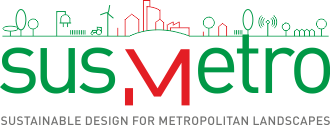The economic focus of SUSMETRO is to identify and functionally integrate market-ready or already operational innovation devices at the interface of nature and society with the goal of establishing new valorisation chains into coherent clusters of activities that help reducing environmental impacts (e.g. CO2 emissions, loss of biodiversity, landscape degradation) while supporting a wider set of societal assets, such as job creation, education or health.
Applying the principles of resource efficiency and urban metabolism as well as vertical and horizontal integration, we seek to create a high level of synergy between operationally different, yet resource-interdependent business environments. Key to the SUSMETRO approach is the implementation of three closely inter-related modules:
- Circular economy as principle of resource efficiency and value creation;
- Disruptive innovation as an integrated approach that links technological, product, process, social and governance dimensions; and
- Nature-based solutions which are attractive and where form and function meet.

Figure 1. Conceptualisation of the Food Innovation Ecosystem between Driving Forces and Citizen Engagement (D. Wascher 2023).
Circular Economy
Making the transition to a circular economy requires a radical transformation of various production chains. The food chain is just one (see Figure 2). Various policy areas are faced with the task of precipitating this transition to a circular food system, for example, in agriculture, the environment, trade, green growth, top sectors and innovation. In order to illustrate such plans, some cities have drawn up a spatial vision for circular economy (see Figure 3).
Firstly, in a circular economy, natural resources must be effectively used and managed. Such resources include soil, water and biodiversity, but also minerals. These resources are essential to be able to produce renewable resources. Secondly, optimum use of food is important. Reducing food waste is an important starting point in this context, as is a diet with less highly processed food, or more vegetable protein and less animal protein.
Also important is a reduced use of natural resources and less environmental pressure. Finally, it is important to make optimum use of residue streams, such as tomato stalks, beet pulp and stale bread. In this way, as biomass rest streams can be recycled towards high value products such as proteins, cosmetics, pharmaceutics or taste improving ingredients (see Figure 4).
All three of these requirements demand action to be able to bring about the transition to a circular food system (PBL Policy Brief 2017).

Figure 2: The circular economy for the food production system (PBL, 2017)

Figure 3: A spatial vision for the Amsterdam circular economy (Circle/Fabric/Amsterdam City, 2015)
The biorefinery -concept or phytomass is a production facility where biomass delivers the carbon source for producing organisms. Bacteria are converting carbon in their metabolism to complex products. Carbon sources can be diverse sugars extracted out of biomass.
Biomass can be created out of a lot of biological material. Companies such as Phytowelt Technologies want to use short rotational plantations of poplar as well as sugar beet pulp which can’t be used for food anymore. The sugar out of biomass can be used by bacteria to produce new substances. The production facility can be considered a “PhytoPark” and produce all future products of the phytomining (industrial biotechnology).

Figure 4: The biorefinery -concept or phytomass is a vision Phytowelt GreenTechnologies GmbH.
Examples of Sustainable Innovation
SUSMETRO follows the evidence-based approach towards sustainable metropolitan systems which is based on a broad notion of innovation which includes the process of learning, knowledge-sharing, governance, education, searching and exploring, resulting in sustainable products, new techniques, new form of organization and new markets (Lundvall, 1995). The added value of innovation is to incorporate several domains to form an integrated innovation approach.

Figure 5: The multi-domain and territorial dimensions of System Innovation (Wascher et al., 2015)
Examples of Food System Innovation
Innovations are vital to transforming our food systems. From local businesses to city projects, these breakthroughs drive change from within. Through the FoodSHIFT 2030 project, SUSMETRO worked with nearly 90 inspiring innovations across nine cities showcase how local efforts are shaping the future of food systems in Europe. The result is an interactive catalog of food system innovations, offering the innovations as four main types: Products, Process, Social, Governance.
The full catalog in PDF format can be downloaded here.
